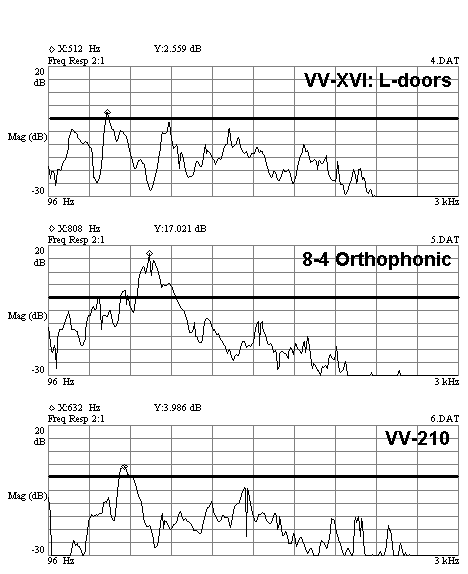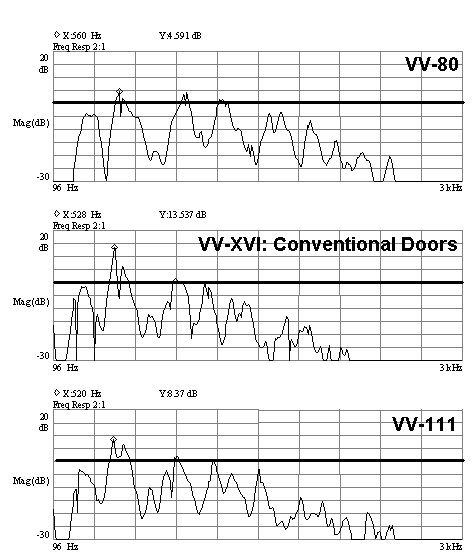The Victor-Victrola Page

Fundamentals of Acoustic Horns
Author: Paul C. Edie
Originally published in the Michigan Antique Phonograph Society Journal, 2000
This article will focus on Victrola horns, and will evaluate the frequency response and efficiency of several designs.
Acoustic horn theory is quite complex. However, basic material on this subject is covered under the heading of "Fundamentals of Phonograph Horns" on this
website. Readers who are interested in a non-technical description of what makes a horn "amplify" sound may wish to read this prefatory material. For
purposes of this article, suffice it to say that a horn is not a true amplifier, but rather acts to match the acoustic impedance of the
soundbox to the listening room. The efficiency and frequency response of the
horn is based on its physical size, shape and the type of material used in its construction.
During the acoustic phonograph era, horn development was mostly an incremental "trial and error"
improvement process; however, the introduction of the internal-horn Victrola proved to be a rather large setback in performance. Horn size and shape became dictated solely by the dimensions and form-factor of
the phonograph cabinet, and not necessarily what produced the best sound. The large horn of a Victor V or VI is
much more efficient than the horn in any Victrola, not only due to size, but also because it retains its internal "roundness" (no square internal edges) from the tonearm to the flare of the horn edge.
Square corners, sharp bends, and abrupt edges cause increased acoustic reflection resulting in decreased efficiency. These design
flaws were partially remedied with the introduction of the Orthophonic Victrola in 1925.
The development of the Orthophonic has been well documented in a number of excellent books, and will not be repeated here. However, one serious aspect
of Orthophonic horns has never been truly addressed in the published literature. The exponential horn equations (that Victor used in its Orthophonic design)
essentially predict the most efficient transfer of acoustic energy by determining the internal horn taper as a function of the horn's dimensions (throat size, length,
etc.). However, as frequency rises, the equations no longer apply, as the movement of high frequency sound waves becomes strongly influenced by internal
reflections. Thus, the Orthophonic horn improves only the bass and lower-midrange portions of the acoustic spectra. Ideally, the optimization equations should
be applied to a straight (non-folded) horn, such that the high frequency sounds have a straight path from soundbox to listener. Obviously, this is impractical, as
a straight horn with the bass performance of a Credenza would be over 6 feet in length. So the "folded horn" concept was used to make the cabinet size
reasonable, without compromising low-end response. However, the use of the folded horn actually can cause increased internal reflections of high frequencies
and decrease treble response. Several books have indicated that the pricier Orthophonics (e.g. Credenza) had frequency response in the range of 100-5000
Hertz, which I had always felt was inaccurate on the high end, especially considering that unfinished wood was used in many of these horns. The semi-rough
wood tends to diffuse higher frequencies, which also have to travel a much greater distance "through the folds" than they did in the simple early Victrolas. The
famous Klipschorn speakers of the 1950's used the folded-horn approach to achieve amazing low-frequency response, but these speakers utilized separately
mounted mid and high frequency horns to avoid having the higher frequencies travel through the folds of the bass speaker. It is important to note that the
advent of electrical recording and the more compliant Orthophonic soundboxes DID serve to increase high-frequency response, but none of these
improvements in the sound can be attributed to the horn design. It is important to remember that the recording
and the soundbox characteristics also play key factors in the overall sound quality of any acoustic phonograph; the horn is only one element in the chain. However, no matter how good the other elements
may be, it is ultimately the horn that determines which frequencies get translated to the listener. My curiosity of how the Victrola horns actually performed
drove me to pursue this testing.
In order to perform these tests, a specialized driver-transducer had to be developed (see Figure 1). A No. 2 Soundbox housing was used, and a piezoelectric
wafer driver element was adapted to fit into the housing. The resulting form-factor was very similar to a conventional soundbox diaphragm. The transducer
could thus be easily adapted to fit any Victrola or Orthophonic tonearm. This element was direct-driven by a power amplifier, and had a response of 90 to
16,000 Hz. at very low power levels (250 mW). An integral microphone element measured the transducer's energy into the tonearm, and an array of 3 B&K
instrumentation microphones located 3 feet away from the phonograph horn were used to spatially average the phonograph's output. In all cases, the original
tonearms were used (since the tonearm is truly an extension of the horn), the "tone doors" were in the full open position, and all machines were checked to
assure that no gaps or leaks were present in the horn structure. White noise was used as a source, and an HP 35670A Spectrum Analyzer was used to
measure both the gain of the horn (how much it amplifies the overall sound) and the horn's frequency response.

Figure 1. Piezo-electric driver mounted on Victrola 4-7. Note that all testing was performed with the tonearm in the "play" position to best replicate the proper arm position
and resulting acoustic path. Caulking-type sealant was used at the soundbox-tonearm interface to eliminate possible air leaks.
Table 1 shows the results. The Victrola model, type of original soundbox that came with the phonograph (and thus the diameter of the tonearm), and horn type
are indicated. The overall gain (efficiency) of the horn in dB's is shown next, wherein 10 dB is subjectively equivalent to a doubling of overall sound volume.
The more efficient (higher dB) horns will provide greater overall volume for a given recording, but may not
provide the best sound quality, which depends in part on the frequency response. For purposes of discussion, the low and high frequency response limits are defined as 30 dB below "zero gain", which in
non-technical terms means a volume which is barely perceptible for normal-level acoustic recordings under typical listening conditions.
|
Model and Original Soundbox |
Type of Horn |
Overall Gain (dB) |
Low Frequency Limit (Hz.) |
High Frequency Limit (Hz.) |
|
VV-XVI "L-doors". No horn slats. Exhibition soundbox. |
Unfolded Square |
11.7 |
144 |
2390 |
|
VV-XVI "Conventional doors" with horn slats. Exhibition soundbox. |
Unfolded Rectangular |
17.9 |
184 |
2200 |
|
VV-111 Larger horn opening. No. 2 Soundbox. |
Unfolded Square |
16.5 |
200 |
2520 |
|
VV-210 Console-type. No. 2 Soundbox. |
Unfolded Square |
12.6 |
248 |
2620 |
|
VV-80 Late version with larger doors. No. 2 Soundbox |
Unfolded Square |
15.4 |
232 |
2580 |
|
VV-IX Tabletop. Exhibition Soundbox. |
Unfolded Rectangular |
10.9 |
280 |
2430 |
|
VV-8-4 Orthophonic |
Horizontal Folded Exponential. Medium Size |
22.8 |
120 |
2220 |
|
VV-4-4 "Granada" Orthophonic |
Unfolded Exponential.Small Size |
21.4 |
160 |
2790 |
|
VV-4-7 Orthophonic |
Horizontal Folded Exponential Small Size |
16.8 |
152 |
1900 |
|
VV-8-12 Orthophonic |
Vertical. Folded Exponential Medium Size |
14.3 |
104 |
2000 |
Table 1. Summary of Horn Performance. A higher "Gain" value indicates better efficiency. A lower "Low Frequency Limit" indicates better bass response. A higher "High
Frequency Limit" indicates better treble response.
The results followed basic acoustic theory expectations quite closely, although the "L-door" XVI exhibited surprising bass response, probably due to the
resonant characteristics of its big open horn cavity. However, on the high end, none of these horns had a frequency response over 3000 Hz. The Orthophonics
have a much better bass response and overall efficiency (at low and middle frequencies) than their predecessors, but the higher frequency range tends to suffer
on models with the folded horns. The unfolded exponential horn of the Granada does not have the bass response of the larger models, but excels in high
frequency characteristics, since the horn's inner surface is quite smooth and the lack of folding within the horn reduces the length of the acoustic path. The
relatively "crushed" folds of the shallow and vertically split 8-12 horn hurts both the overall efficiency and high frequency response, although bass
characteristics are excellent.
Finally, the overall "smoothness" of the frequency response curve is highly important to the overall sound quality; a lot of humps and drops in the response can
result in a tinny, canned or "hollow" sound, regardless of the bass or treble response limits. The response curves are shown in Figure 2. Most of these horns do
not have very smooth response characteristics by today's standards, although the Orthophonics tend to be better
overall. The real winner here is the Granada (4-4) horn, which reveals a reasonably smooth curve at a reasonable overall efficiency, albeit at the expense of reduced bass response.


Figure 2. Frequency Response Curves of Victrola Horns. These plots span a range of 100 to 3000 Hz. and show the gain in dB's for each discreet frequency. The bold
horizontal line represents "zero" gain, wherein the output of the horn is exactly equal to the input at that frequency. The smoother the curve, the truer the overall reproduction.
Bass and treble response limits are seen at the point where the curve" drops" off the graph on either end. The 4-4 (Granada) has the smoothest response of all machines tested.
Unfortunately, at the time of this testing, my Credenza was apart for repairs to the horn seals.

